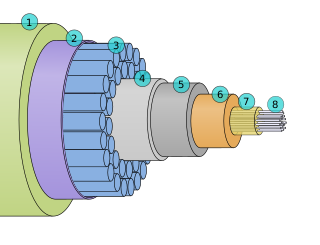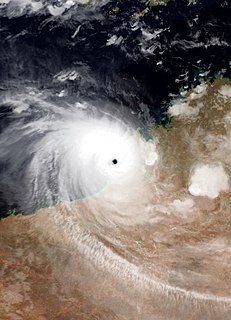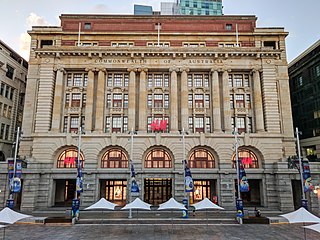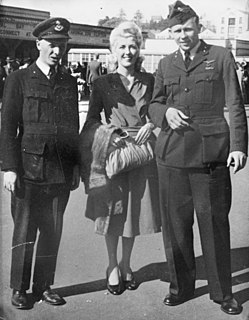
A submarine communications cable is a cable laid on the sea bed between land-based stations to carry telecommunication signals across stretches of ocean and sea. The first submarine communications cables laid beginning in the 1850s carried telegraphy traffic, establishing the first instant telecommunications links between continents, such as the first transatlantic telegraph cable which became operational on 16 August 1858. Subsequent generations of cables carried telephone traffic, then data communications traffic. Modern cables use optical fibre technology to carry digital data, which includes telephone, Internet and private data traffic.

Broome, also known as Rubibi by the Yawuru people, is a coastal, pearling and tourist town in the Kimberley region of Western Australia, 1,681 km (1,045 mi) north of Perth. In the 2021 census the population was recorded as 14,660. It is the largest town in the Kimberley region.

The Electric Telegraph Company (ETC) was a British telegraph company founded in 1846 by William Fothergill Cooke and John Ricardo. It was the world's first public telegraph company. The equipment used was the Cooke and Wheatstone telegraph, an electrical telegraph developed a few years earlier in collaboration with Charles Wheatstone. The system had been taken up by several railway companies for signalling purposes, but in forming the company Cooke intended to open up the technology to the public at large.

The All Red Line was an informal name for the system of electrical telegraphs that linked much of the British Empire. It was inaugurated on 31 October 1902. The name derives from the common practice of colouring the territory of the British Empire red or pink on political maps.

PK Porthcurno is a museum located in the small coastal village of Porthcurno Cornwall, UK. Porthcurno was the point at which many submarine telegraph cables—transatlantic and to other locations—came ashore. The first cables were direct current impulse transmitters. The first cables with transistor amplifiers were laid in the 1950s.

Roebuck Bay is a bay on the coast of the Kimberley region of Western Australia. Its entrance is bounded in the north by the town of Broome, and in the south by Bush Point and Sandy Point. It is named after HMS Roebuck, the ship captained by William Dampier when he explored the coast of north-western Australia in 1699. The Broome Bird Observatory lies on the northern coast of the bay.

Siemens Brothers and Company Limited was an electrical engineering design and manufacturing business in London, England. It was first established as a branch in 1858 by a brother of the founder of the German electrical engineering firm Siemens & Halske. The principal works were at Woolwich where cables and light-current electrical apparatus were produced from 1863 until 1968. The site between the Thames Barrier and Woolwich Dockyard has retained several buildings of historic interest. New works were built at Stafford in 1903 and Dalston in 1908.

Sir John Pender KCMG GCMG FSA FRSE was a Scottish submarine communications cable pioneer and politician.

The Australian Overland Telegraph Line was a 3,200 km (2,000 mi) telegraph line that connected Darwin with Port Augusta in South Australia. Completed in 1872, the Overland Telegraph Line allowed fast communication between Australia and the rest of the world. An additional section was added in 1877 with the completion of the Western Australian section of the line. It was one of the great engineering feats of 19th-century Australia and probably the most significant milestone in the history of telegraphy in Australia.

Severe Tropical Cyclone Rosita was a tropical cyclone that affected northern Australia from 15 April through 21 April 2000. Rosita was one of the most intense tropical cyclones to hit the west Kimberley coast in the last century. Crossing the coast as a Category 5 about 40 kilometres (25 mi) south of Broome on 20 April, Rosita caused severe damage in the Eco Beach resort and the vegetation around Broome. Its region of very destructive winds passed south of Broome by only 15 kilometres (9.3 mi). Cyclone Rosita was the first cyclone to directly hit Broome since Cyclone Lindsay in March 1985.
Australian non-residential architectural styles are a set of Australian architectural styles that apply to buildings used for purposes other than residence and have been around only since the first colonial government buildings of early European settlement of Australia in 1788.

Cable Beach is a 22 km (14 mi) stretch of white sand beach on the eastern Indian Ocean and the name of the surrounding suburb in Broome, Western Australia. Cable Beach was named after the telegraph cable laid between Broome and Java in 1889. Low cliffs of red ochre rise behind the very flat and wide beach, with waves that are mostly gentle in the dry season from May to October. In 2016, the population was 5,436.

Australia was a relatively early adopter of electrical telegraph technology in the middle of the nineteenth century, despite its low population densities and the difficult conditions sometimes encountered in laying lines. From 1858 onwards, the major capitals were progressively linked, culminating in the addition of Perth in 1877. Australia was linked to the rest of the world for the first time in 1872, through the Overland Telegraph which ran some 3,200 kilometres (2,000 mi) from Adelaide through to Darwin. The network continued to expand in size and sophistication until 1959 and in heavy usage until 1945, after which time telephone usage began to erode public patronage of telegraphy services. The final publicly provided telegraphy service was closed in 1993.

The General Post Office is a heritage landmark building in Perth, Western Australia. Located on the western side of Forrest Place in the city's central business district, its imposing stone facade is in the Beaux-Arts style. The building was completed in 1923 after almost a decade of construction, which was protracted by World War I and the resulting shortages of construction materials. At the time of its opening, it was the largest building in Perth.
Mundiwindi is a ghost town in the Pilbara region of Western Australia. The town is around 1,150 kilometres (710 mi) north east of Perth and 124 kilometres (77 mi) south east of Newman, along the Jigalong Mission road.

Robert John Sholl was a government administrator, magistrate, explorer, journalist, entrepreneur, harbourmaster, customs official, postmaster and lay reader in Western Australia (WA), during the colonial era. Because of his multiple, simultaneous roles, which carried judicial, political, cultural and commercial power and influence, Sholl is regarded as a significant figure in the history of North-West Australia, at an early stage of its settlement by Europeans.

The Pacific Cable Station was built in 1902 in Southport, Gold Coast City, Queensland, Australia, continuing to operate for sixty years, finally closing in 1962. While most of the site has been dismantled, the Southport Cable Hut remains and has been listed on the Queensland Heritage Register and the Gold Coast Local Heritage Register.

Willem Frederick August "Gus" Winckel was a Dutch military officer and pilot who flew for the Royal Netherlands East Indies Air Force (ML-KNIL) in World War II. During the attack on Broome, Western Australia, on 3 March 1942, Winckel managed to land his plane full of refugees safely on the Broome airstrip just before the Japanese attack. He then dismounted the plane's machine gun and shot down one of the Japanese fighters, the only Allied "kill" during the attack.
Main Roads Western Australia controls the major roads in the state's Kimberley region. Great Northern Highway is the major road connection through the region, with sealed roads spurring off it to connect to population centres, and unsealed roads offering an alternative route between Derby and Wyndham.
Roebuck Plains Station is a pastoral lease that is located close to the township of Broome in the Kimberley region of Western Australia. It is one of the closest pastoral leases to Broome.
















